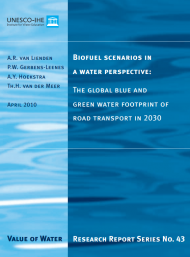
Biofuel Scenarios in a Water Perspective: The Global Blue and Green Water Footprint of Road Transportation in 2030

Concerns over energy security and climate change stimulate developments towards renewable energy. Transport is expected to switch from fossil fuel use to the use of fuel mixtures with a larger fraction of biofuels, e.g. bio-ethanol and biodiesel. Growing biomass for biofuels requires water, a scarce resource. Existing scenarios on freshwater use usually consider changes in food and livestock production, and industrial and domestic activities. This research assesses global water use changes related to increasing biofuel use for road transport in 2030 and evaluates the potential contribution to water scarcity. To investigate water demand changes related to a transition to biofuels in road transport, the study combines data from water footprint (WF) analyses with information from the IEA APS energy scenario for 2030. It includes first-generation biofuels, bio-ethanol from sugar cane, sugar beet, sweet sorghum, wheat and maize, and biodiesel from soybean, rapeseed, jatropha and oil palm. Under the IEA APS scenario, the global biofuel WF will increase more than tenfold in the period 2005–2030. The USA, China and Brazil together will contribute half of the global biofuel WF. In many countries, blue biofuel WFs significantly contribute to blue water scarcity. The research provides a first exploration of the potential contribution of transport biofuel use to blue water scarcity. In 2030, the global blue biofuel WF might have grown to 5.5% of the totally available blue water for humans, causing extra pressure on fresh water resources. When biofuel use continues to expand after 2030, countries should therefore consider the water factor when investigating the extent to which biofuels can satisfy future transport energy demand.
- Issues:
- Infrastructure, Energy, Climate Change, Natural Resources
- Region:
- Global
- Year Published:
- 2010
- Authors:
- A.R. Van Lienden, A.Y. Hoekstra, Th.H. Van Der Meer, P.W. Gerbens-Leenesa
- Institutions:
- UNESCO Institute for Water Education (UNESCO-IHE), United Nations, UNESCO

